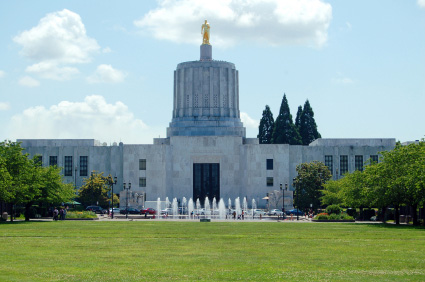 At the Oregon Leadership Summit, business and government leaders unite in calling for PERS reform, education investment and a decision on the Columbia River Crossing.
At the Oregon Leadership Summit, business and government leaders unite in calling for PERS reform, education investment and a decision on the Columbia River Crossing.
 In 1999, Nik Blosser, president of Celilo Group Media, helped found the Oregon Business Association, a statewide advocacy group. “I was the one who signed the articles of incorporation,” says Blosser, who became OBA board chair this past September. “They made me chair so they could eventually kick me out.”
In 1999, Nik Blosser, president of Celilo Group Media, helped found the Oregon Business Association, a statewide advocacy group. “I was the one who signed the articles of incorporation,” says Blosser, who became OBA board chair this past September. “They made me chair so they could eventually kick me out.”
I met up with Blosser at yesterday’s 10th annual Oregon Leadership Summit, where we chatted briefly about the remarkable display of unity among Oregon business and government leaders — and the challenges of passing the 2013 Oregon Business Plan agenda.
Today, he continues to play a leadership role in a business association that is playing an increasingly prominent leadership role in crafting Oregon public policy. Three of the priority items on OBA’s 2013 legislative agenda are PERS reform, continued redesign of educational institutions, and funding the Columbia River Crossing. Those three goals align almost exactly with Gov. John Kitzhaber’s priorities, outlined yesterday in a speech that itself was almost a carbon copy of the governor’s press conference on Friday.
Then there was the theme of the leadership summit, written in bold on the summit agenda: “Fix PERS, invest in education and build the bridge.”
You gotta hand it to Oregon’s business leaders. They’ve picked up a thing or two from the world of branding and learned how to craft a political message.
And repeat it.
Over and over.
Hammer home the message is exactly what yesterday’s speakers did: Democrat and Republican, public sector and private, the governor, Schnitzer Steel Board chair John Carter and Sen. Peter Courtney (D-Salem), who weighed in by video. Summit organizers also hired local media startup Epipheo to put together and broadcast a neat little video about the Oregon Business Plan strategy: “More jobs=better schools.” (Oh, and the only summit swag was a pin, affixed with the logo: “Build the bridge”).
Is the business community really as unified as it appeared on stage? For the time being, yes, said Blosser, noting that the OBA was created as a progressive alternative to existing business organizations. “Now people are unified,” he said. “But that hasn’t always been the case.” A year after the formation of the OBA, a coalition of business leaders launched the Oregon Business Plan, a long-term strategy to grow jobs and the economy in part by redesigning public services such as health care, education and prisons.
The result is a business-government collaboration that people inside and outside the state deem nothing less than extraordinary. “You don’t generally become a chair of a business association to talk about prisons or public employee benefits,” observes Blosser. You do if you’re a member of the OBA, with a corrections reform agenda that includes a call for “no beds and no bonds” in the next biennium.
Kitzhaber and the Oregon Business Plan also make corrections reform a priority, with a focus on investing more in prevention and less in prison construction. Even Associated Oregon Industries, considered more old school when it comes to business advocacy, is focusing on education and health care in addition to conventional economic development issues such as industrial lands and new business permitting.
Ironically, Blosser started his own green publishing business more than 10 years ago in part because he was concerned about the slow pace of change in the public policy world, especially in the sustainability sector. (Full disclosure: I worked for Blosser nine years ago, when he was publisher of Sustainable Industries Journal, a pioneering green business magazine.) He says the reason business groups are now coalescing around, and rapidly advancing, public services issues is because the objectives, such as strengthening education and reining in health care costs, are more “common sense” than ideological.
Whether business and government leaders will unite on other issues, such as the energy and environmental concerns that first animated Blosser, remains to be seen. In the meantime, a united front among business leaders won’t be all it takes to pass the 2013 agenda, and cracks will likely appear once the session gets underway in January. “It really all comes down to the legislature,” says Blosser, who likens the grueling Salem legislative process to “sausage making.” The financial and legal complexities of the PERS system only add to the challenges, he said.
Read more about the 2013 Oregon business agenda — the united front and potential cracks in that front — in OB’s January issue, which is out next week.
Linda Baker is managing editor of Oregon Business.


